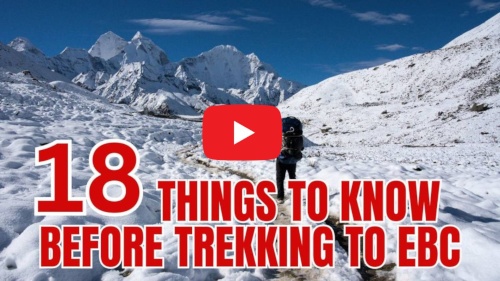We’re a small team of three who just returned from Lukla to Kathmandu after completing the Everest Base Camp trek. October is usually known for its clear skies and ideal trekking weather, but this year turned out differently. We were met with heavy rain and snow throughout the journey. Thankfully, the Nepal side wasn’t hit as hard as Tibet, where hundreds of trekkers were stranded by a snowstorm. In this article, we’ll share our Everest Base Camp tips firsthand, practical, honest, and perhaps a little different from what you’ll find in other articles. We hope it helps you prepare for your own adventure to Everest Base Camp.

So our EBC adventure turned out to be more dramatic than expected, marked by AMS, relentless rain, and thick autumn snow. Still, it was an unforgettable experience filled with lessons that went far beyond the usual “Things to Know Before Your EBC Trek” lists.
Disclaimer: We’re not professional hikers. The information shared here is based solely on our personal experience during the trek. Please cross-reference with other reliable sources to get a more complete picture of what to expect and how to prepare.
1. What Shoes Should You Wear for the Everest Base Camp Trek?
You’ll be surprised to see many locals walking the Everest trails in simple walking shoes, and some even in sandals! I’m not suggesting you do the same, of course, but it does show that the type of shoe isn’t the only thing that matters. What truly counts is comfort, familiarity, and knowing your limits on the terrain.
As foreign trekkers who aren’t used to the rocky and often slippery mountain paths, choosing the right shoes becomes more important. Here’s what I learned from my own experience:
We each brought two pairs of hiking shoes, just in case one broke during the trek. I packed two pairs of the same model from the same brand, both already well broken in. That turned out to be one of my best decisions.
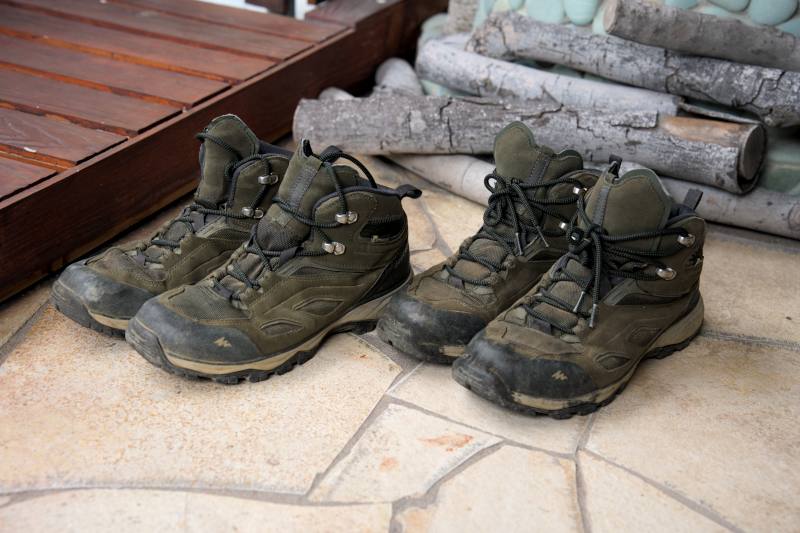
Even if you trek during what’s supposed to be the dry season, the weather in the Himalayas can change without warning. When we hiked from Namche Bazaar to Tengboche, it rained the entire day. The next day, from Tengboche to Dingboche, it snowed heavily from morning to evening. Even high-ankle boots couldn’t fully prevent moisture from seeping in. Rain and melting snow dripped down between the gap of the shoe and socks. My shoes were completely soaked and took two full days to dry.
Thankfully, I had my spare pair of dry shoes and socks, which saved the day once the weather cleared up.
Both pairs of my shoes were waterproof, which was extremely helpful after the snowfall. They kept my feet dry when crossing muddy patches or shallow streams.
In short:
- Bring two pairs of reliable, broken-in hiking shoes if possible.
- Make sure the shoes are waterproof.
- Don’t rely on weather forecasts. The mountain has its own plans!
2. What Clothes Do You Need to Bring?
From my experience, the best way to dress for the Everest Base Camp trek is to layer your clothing. This allows you to adjust easily as the temperature changes throughout the day.
I usually start with a base layer to keep warm, then add a quick-dry long-sleeve shirt with SPF 50, and finish with a down jacket on top. This setup worked perfectly even when the temperature hovered around zero degrees in the morning.
When hiking at lower altitudes, like from Phakding to Namche Bazaar, I often removed the down jacket after half an hour of hiking as my body warmed up. The long-sleeve shirt with SPF protection helped prevent sunburn, so I only needed sunscreen on my hands, neck, and face.
Since my body constantly generates heat while moving, I did not feel too cold even at higher altitudes around 4,000 meters (for example, at Dingboche). This clothing combination was sufficient for me in October.
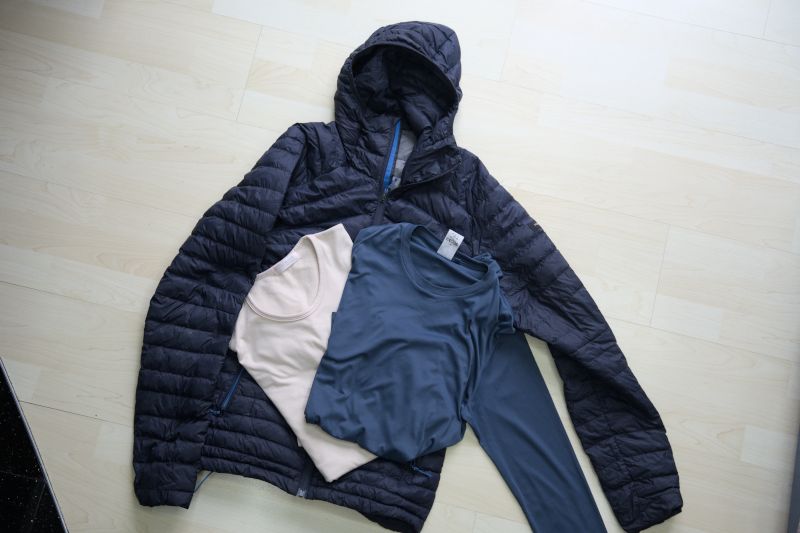
Nighttime, however, is a different story. It gets very cold. The blankets provided by tea houses are usually not enough, so a sleeping bag is essential. Our tour operator, Grande Adventure, arranged sleeping bags for us, which saved us the trouble of bringing them from home.
A raincoat is also mandatory. I used mine several times during this trek and also on my previous Annapurna Base Camp trek. I prefer a poncho-style raincoat that’s large enough to cover my backpack, so there's no need for a separate rain cover for the backpack. My teammates used backpack covers, but since those didn’t fully protect the bags, parts of their backpacks still got wet.
Lastly, don’t underestimate the sun at high altitude. The sunlight reflecting off snow can cause serious sunburn. One of my teammates got his hands badly sunburned.
3. Are You Concerned About the Cleanliness of Drinking Water?
Throughout the trek, we mostly purchased boiled water from tea houses. The price varies greatly depending on altitude. It is around Rs100 per liter in Lukla, steadily rising as we climb higher. By the time we reached Gorakshep, it was as high as Rs500 per liter (as of October 2025). Since our meals were included in the tour package, drinking water actually became our biggest daily expense.
So, is the boiled water safe to drink?
Generally, yes, but there’s a catch. Water boils at a lower temperature at higher altitudes (for example, about 84°C in Dingboche, at 4,400 meters). To ensure safety, it needs to be kept at a rolling boil for at least 3–5 minutes to kill bacteria and viruses. We had to trust that the kitchen staff followed this properly, and fortunately, none of us experienced any stomach issues.
You can also buy bottled mineral water, which is slightly cheaper since it doesn’t require boiling. (It was sold at Rs60 per liter.) However, I chose not to, mainly to reduce plastic waste on the mountain.
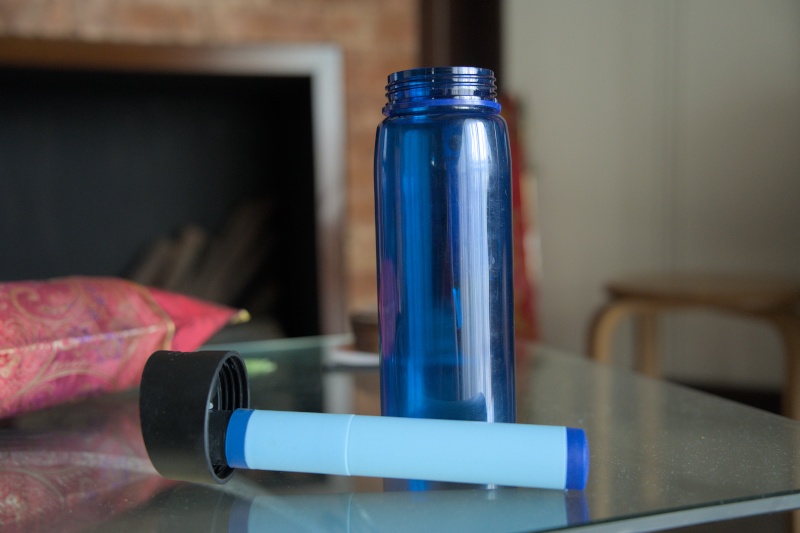
If, like me, you’re a bit cautious about water safety, I highly recommend carrying water purification tablets such as Aquatabs. I use one tablet per liter, and the water is safe to drink after 30 minutes. If you find the chlorine smell a bit strong, just wait for an hour. By then, it completely evaporates, and the chlorine smell should have completely gone.
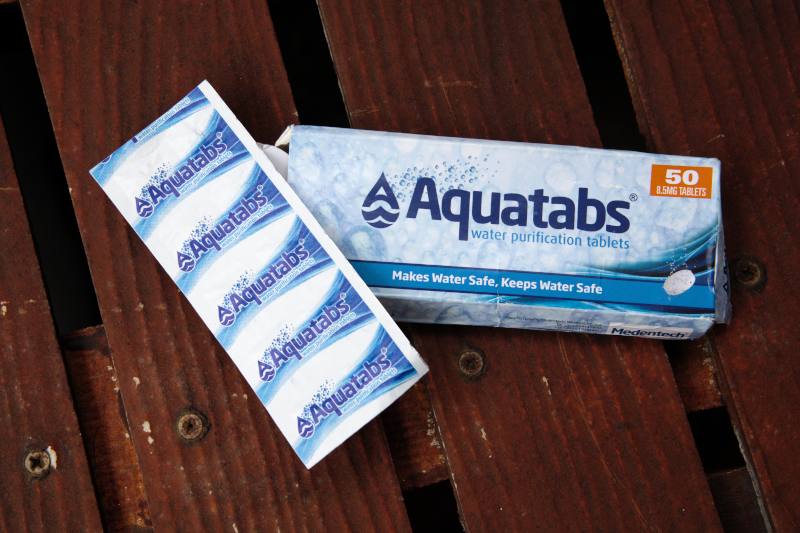
4. What to Expect from the Menu at Different Tea Houses?
Having done the Annapurna Base Camp trek last year, I found the food options along the Everest Base Camp route are quite similar. Most tea houses serve the same familiar set of dishes.
Common meals include fried rice, fried noodles, dal bhat, thukpa (Tibetan noodle soup), momo (dumplings), macaroni, spaghetti, and of course, Korean instant noodles, a popular choice for trekkers craving something simple and hot.
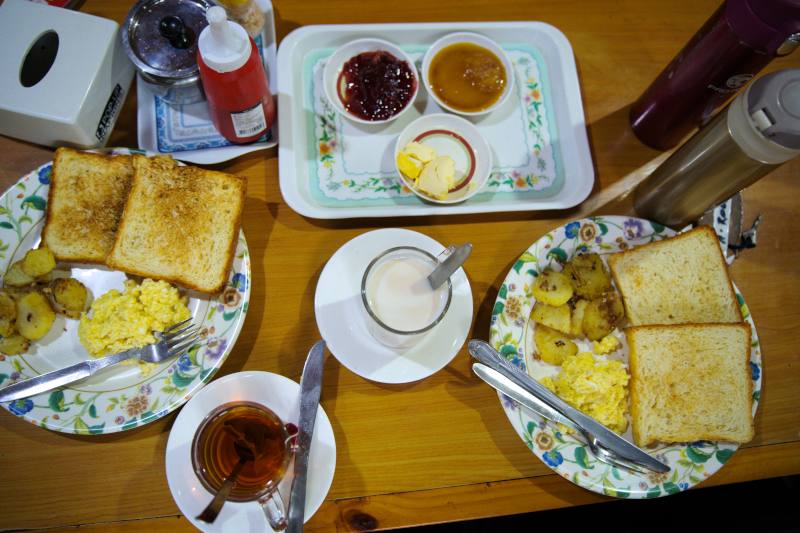
From our experience:
- Fried rice and fried noodles are good, filling choices for lunch or dinner. Just note that many places top their fried rice with shredded cheese, which might surprise most Asian people! If you prefer it plain, make sure to request “no cheese.”
- Thukpa and instant noodles come in smaller portions, perfect for breakfast or a light meal, but not enough for lunch and dinner.
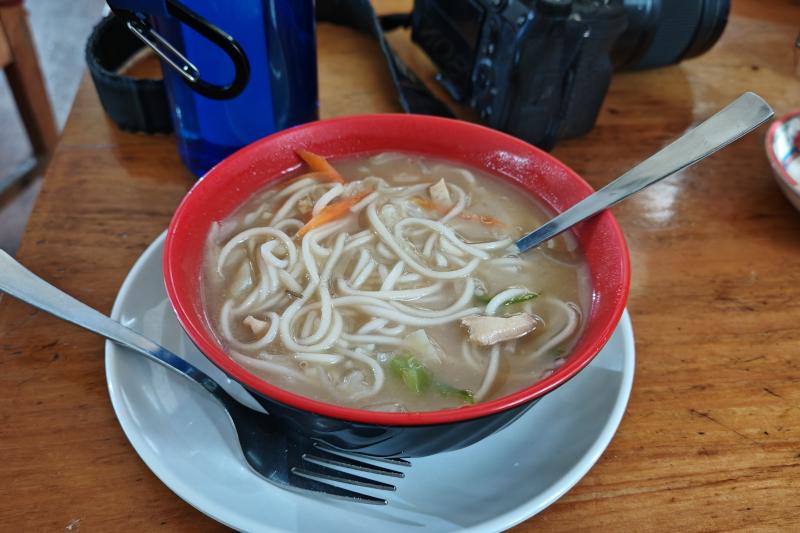
- Dal bhat is the best value for big eaters since it comes with free refills of rice, lentil soup, and curry.
- For drinks, the most popular option by far is ginger honey lemon tea, believed to help counter symptoms of altitude sickness. If you’re a coffee lover, be prepared to be served only instant coffee in most places. There are only a few larger tea houses that have espresso machines for freshly brewed coffee.
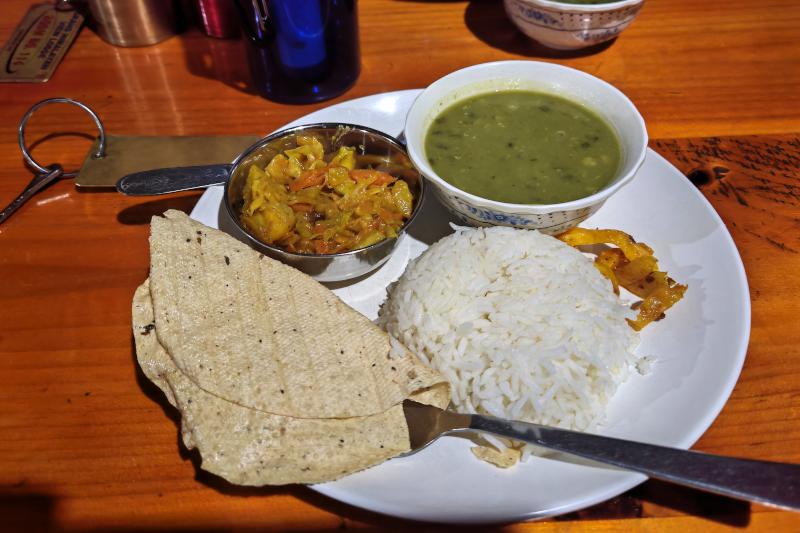
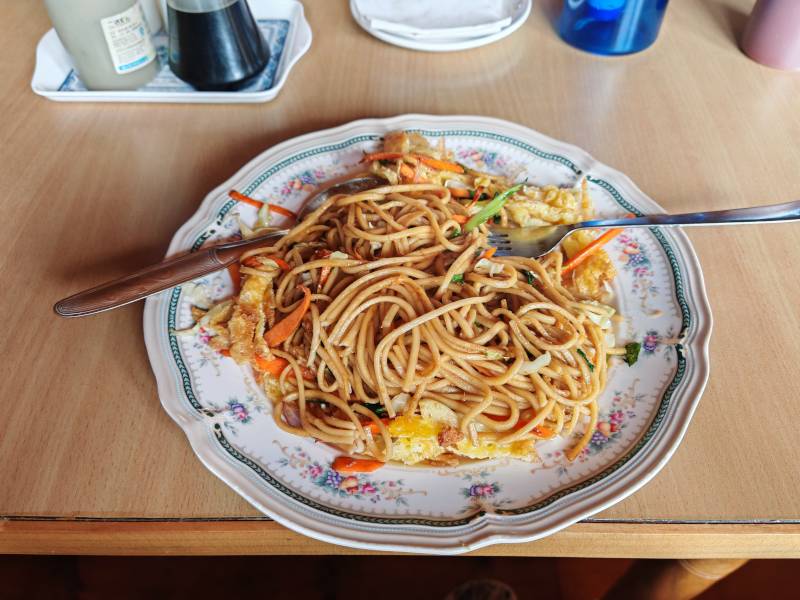
5, How About the Price of Food and Drink?
Food in the mountains isn’t cheap, and that’s perfectly understandable once you realize that everything has to be carried up by porters or yaks. For example, a simple spaghetti bolognese I ordered at a tea house in Namche Bazaar cost Rs800, about the same as what I’d pay at a decent restaurant in Kathmandu.
As you climb higher, the price of food continues to increase. By the time you reach the higher villages like Lobuche or Gorakshep, even a basic fried rice can be priced at xxx.
Besides accommodation, food will likely be your second biggest expense during the trek. Below are some photos of food menus we captured along the way to give you a sense of how prices change with altitude.


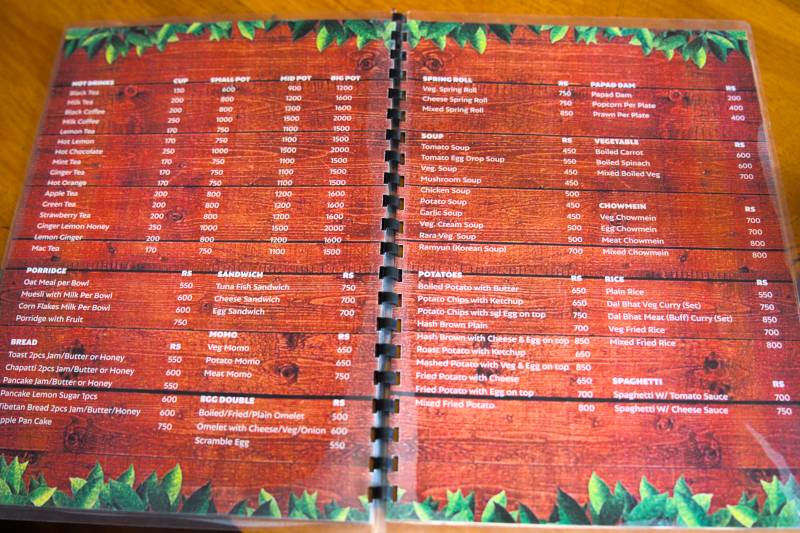
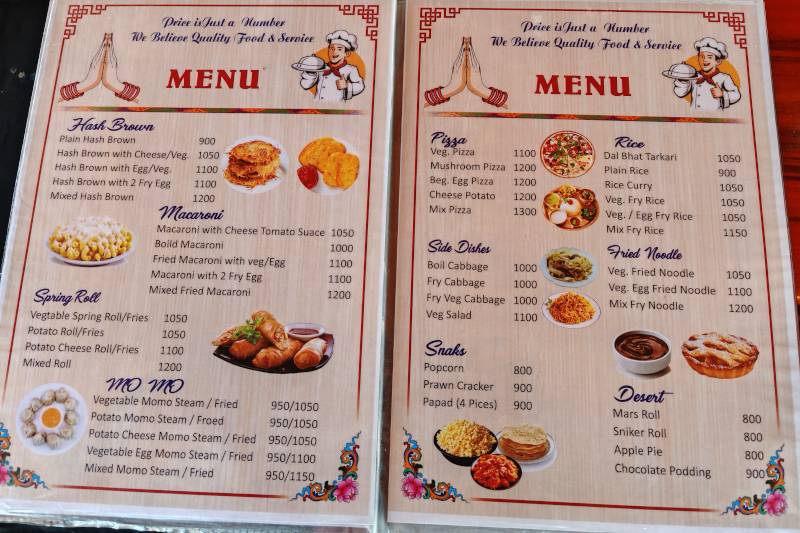
6. Do the Rooms Have Attached Bathrooms?
At lower altitudes, such as from Lukla up to around Tengboche, you can still find rooms with attached bathrooms if you’re particular about comfort. However, once you go higher, most tea houses only offer shared toilets located outside your room.
By the time you reach Lobuche or Gorakshep, toilets become more basic. Some don’t even have a sink or running water. It’s part of the mountain experience, so it’s best to be mentally prepared for simpler facilities as you ascend.
The good news is that all the tea houses we stayed in had sitting toilets, which made things easier. I only came across one squat toilet in a small café while descending from Namche Bazaar to Phakding.
7. Is WiFi Available?
Yes, WiFi is available at most tea houses, but don’t expect high-speed connectivity. Up to around 4,000 meters, I still get intermittent WiFi with a 4G signal, though it can be quite unstable.
You can buy local SIM cards such as Ncell or NTC, both of which work reasonably well in lower villages. I took an easier way by activating international roaming from our home country, which automatically connects to the strongest network available at any location.
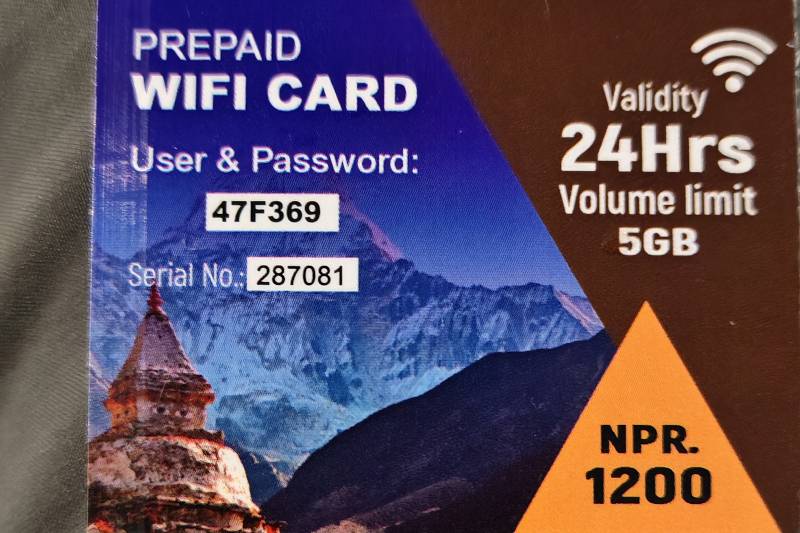
After Dingboche, however, WiFi becomes almost nonexistent. To stay connected, I purchased a WiFi card that runs on satellite signal, which costs Rs 1,200 for 5GB, valid for 24 hours. It’s expensive, but the advantage is that it works across different tea houses. All I needed was to log in to the network of that particular tea house.
Some trekkers choose to go completely offline, embracing the peace and simplicity of mountain life. For us, though, staying connected was reassuring. It allowed us to keep in touch with family and let them know we were safe.
8. Are Crampons Necessary?
Since it was autumn and the forecast promised clear skies, we didn’t expect to walk on ice at all. But nature had other plans. A sudden heavy snowfall has completely covered the trek, and we soon found ourselves struggling to hike on ice.
Thankfully, our tour agent, Grande Adventure, quickly arranged crampons for us. Walking on the icy trail became much easier and far less risky.

My advice? Bring a pair, even if you think you won’t need them. They’re lightweight, compact, and can be a real lifesaver when the weather takes an unexpected turn, just like it did for us.
9. Can You Charge Your Electronic Gadgets in Your Room?
At lower-altitude tea houses, most rooms come with electrical outlets, so you can easily charge your devices. However, as you climb higher, electricity becomes scarcer and more expensive.
In some places, you’ll need to pay a small fee (around Rs200) to activate the electric socket in your room. Higher up, many lodges run on solar power, and charging can only be done at the dining area for a price. For example, at Deboche, I paid Rs500 to charge my phone and Rs1,000 for my power bank.
To save money, I recommend charging a large power bank instead of charging your devices individually. My 65W power bank keeps both my phone and camera running for 2 to 3 days.
Also, don’t forget to bring a universal adapter, as the socket types can vary from your gadgets.
10. Will You Get Sunburn?
Absolutely, and faster than you might think. At high altitude, the UV index is much stronger because the air is thinner and absorbs less ultraviolet radiation. If there’s snow, the effect is even greater due to the reflection of sunlight off the white surface.
I was lucky. I applied plenty of sunscreen, wore a long-sleeved SPF 50 shirt, sunglasses, and a neck gaiter pulled up to protect my chin and mouth.
But my teammates Ka Kui and Bernard weren’t so fortunate. They underestimated how intense the sun’s reflection could be from Lobuche onward. Both ended up with burned noses, cracked lips, and peeling skin on their hands.
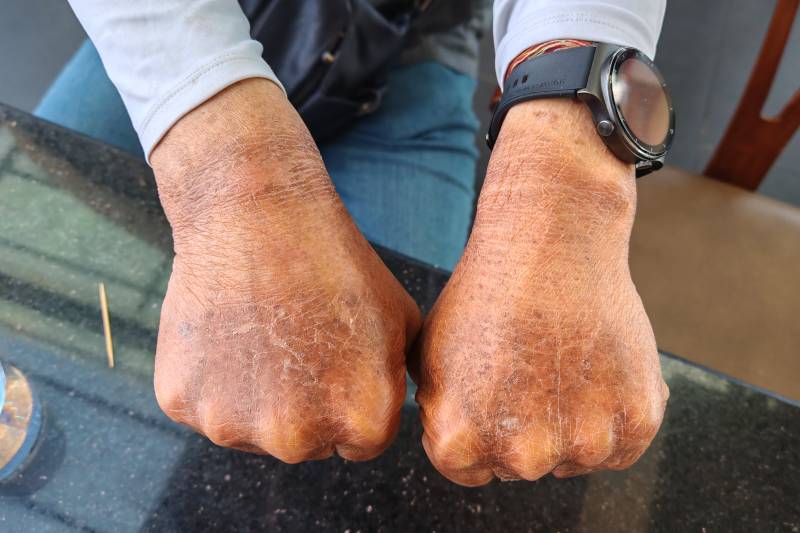
The best protection? Cover up as much as possible, and apply generous layers of sunscreen on all exposed skin, especially your face, neck, and hands. Prevention is far better than dealing with painful sunburn at 5,000 meters!
11. Is AMS a Real Concern?
Absolutely. I experienced it firsthand at Dingboche (4,410m), where I was suddenly hit by Acute Mountain Sickness (AMS) upon arrival amidst heavy rain. I couldn’t eat anything for dinner except a bowl of garlic soup, and when I checked my SpO₂ level, it had dropped to 67, far below normal.
The next morning, I skipped the acclimatization hike to Nangkartshang Hill. My oxygen level recovered quickly to 76 the following day, but I made the rational decision not to continue higher, as I didn’t want to cause inconvenience to my teammates.
Both of them, however, had SpO₂ readings near 90 and showed no symptoms of AMS. They successfully reached Everest Base Camp (EBC) without any issues.
So yes, AMS is very real. Even though I was physically fit, no joint pain, no muscle fatigue. But it didn’t protect me from altitude sickness.
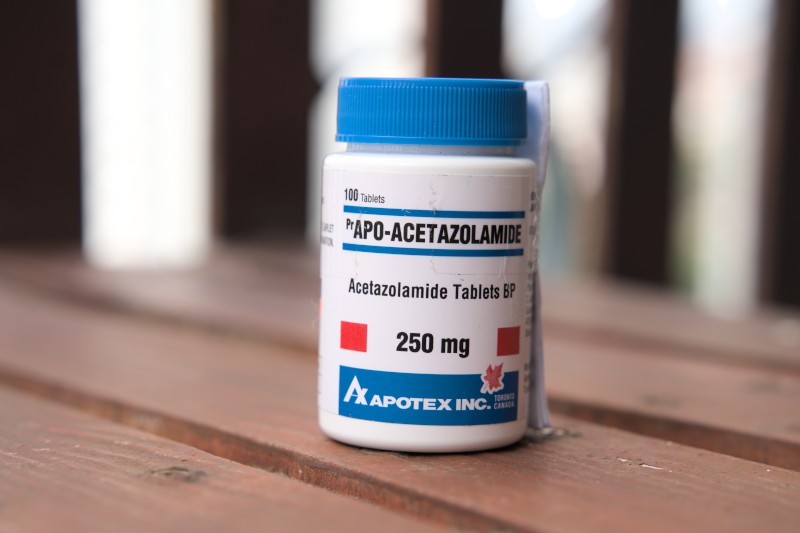
I took acetazolamide (Diamox) and even tried Rhodiola rosea (红景天), a herbal supplement often used to prevent high-altitude sickness, but neither prevented the onset. The truth is, AMS can affect anyone, regardless of fitness level or preparation. The best you can do is ascend gradually, stay hydrated, and listen to your body.
12. Is a DSLR Too Troublesome If You’re a Serious Photographer?
Yes and no. It really depends on the weather.
As an avid amateur photographer, I brought my full-frame DSLR, hoping to capture the best shots possible. I kept a 28–85mm zoom lens on the camera to avoid changing lenses on the dusty trails.
However, when it started raining and snowing, things got complicated. The 72mm lens glass easily caught water droplets, and I constantly had to stop to wipe it clean. It became a chore, and I had to keep the camera hidden under my poncho, making it cumbersome to access quickly.
In the end, I relied on my mobile phone for most of the photos and videos during bad weather. The convenience outweighed the superior quality of the DSLR under such conditions.
If you’re a serious photographer, my advice is to bring your best camera, but be realistic. When the weather turns harsh, your camera can become a burden.
13. Are Sunglasses a Must?
Yes, without question.
The UV index at high altitude is consistently high, and when sunlight reflects off snow, the glare can be blindingly intense. Even if you’re not concerned about UV exposure, the brightness alone is unbearable without eye protection.
I use clip-on sunglasses over my regular glasses, which works well because I can easily flip them up when taking photos or videos. However, they don’t block sunlight from the sides, so they’re less effective on snowy terrain where light reflects from every angle.
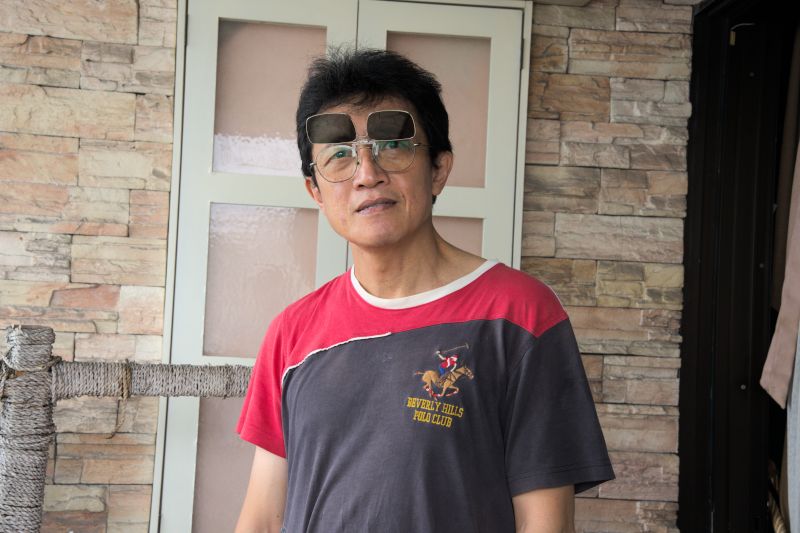
For the best protection, choose wraparound sunglasses that seal completely around your eyes. A pair with Category 3 UV protection should be sufficient for these trekking conditions.
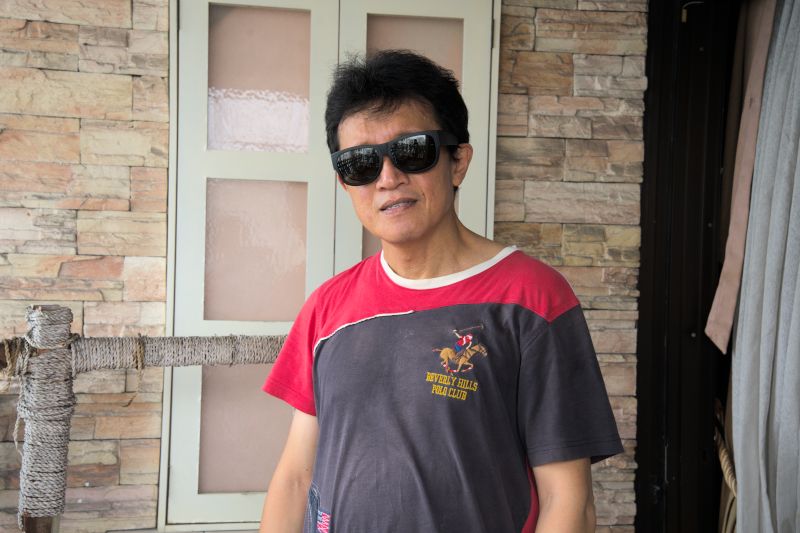
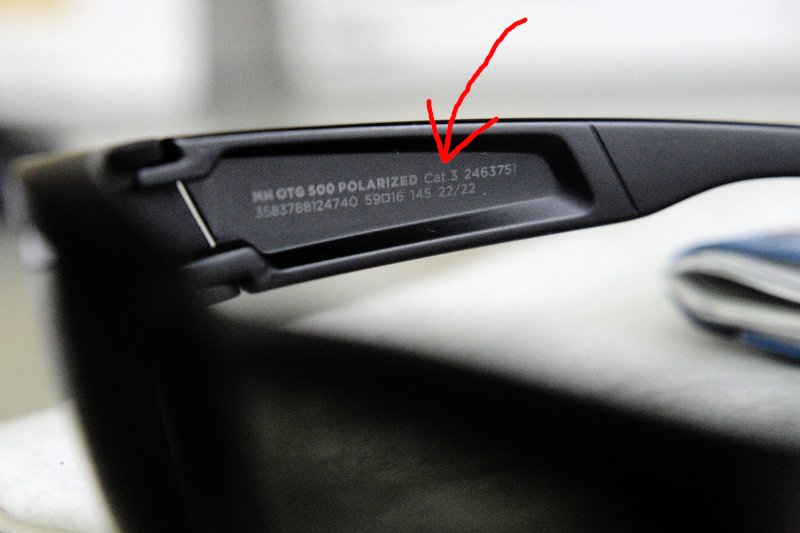
14. How to Keep Yourself Clean If You Decide Not to Shower?
We decided not to shower for the entire EBC trek. It might sound extreme, but in the cold mountain conditions, it was actually the most practical choice. Of course, hot showers are available at most tea houses for an extra fee. But at high altitude, the freezing temperature and limited facilities often make it less appealing.
To stay reasonably clean, I brought a few essentials:
- Alcohol swabs – to clean the toilet bowl before use.
- Antiseptic wet wipes – for wiping down my face, neck, and body each evening.
- Toilet paper – always carry your own, as most tea houses don’t provide any.

These simple items kept me feeling fresh enough throughout the trek. And of course, nothing beats the feeling of that first proper hot bath back in Kathmandu after days of mountain dust and cold!
15. What If You Need to Purchase Hiking Gear at the Last Minute?
If you forget to pack something, don’t worry. Thamel in Kathmandu has you covered. This popular tourist district is packed with outdoor gear shops offering everything from trekking poles, down jackets, and gloves to sleeping bags and rain gear.
If you miss getting something in Kathmandu, you can still find gear at Lukla and Namche Bazaar, although the prices increase the higher you go. Namche is usually the last major stop with a decent range of supplies.
16. What Are the Most Common Souvenirs?
Souvenir shopping is a small joy after completing the EBC trek. I picked up a few items along the way, including:
- Fridge magnets and embroidered T-shirts from Lukla (Rs 600–700)
- EBC trekking map (1:60,000 scale) from Kathmandu for Rs 175
- A small singing bowl from Lukla for Rs 800
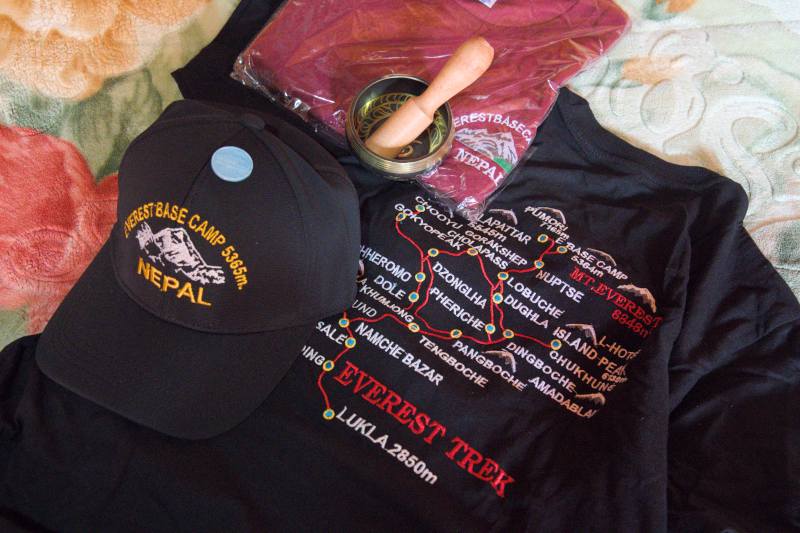
Interestingly, there isn’t much price difference between Lukla and Kathmandu for small souvenirs, so you can buy them wherever you find something you like.
17. How much local currency do you need?
Since our tour package already covered accommodation and three meals a day, the main expenses in the mountains were drinking water, charging fees for phones and power banks, snacks and drinks, WiFi cards, and souvenirs. I budgeted around USD 25 per day, as I didn’t plan to spend on hot showers, pubs, hair salons, or massages at Namche Bazaar.
I need to exchange your money for Nepalese Rupees (NPR) as that is used on the EBC trek. Since I stayed in Thamel, Kathmandu, it's very convenient to change money there as money changers are available on almost every corner. Interestingly, most of them offer the same exchange rate, so I can confidently walk into any of them without worrying about unfair rates.
I also exchanged more cash at Namche Bazaar, but the rate was slightly less favorable compared to Kathmandu.
The money changers accept most common currencies, including US Dollars, Malaysian Ringgit (I’m from Malaysia), and Hong Kong Dollars (my brother is from Hong Kong). However, USD is still the most widely accepted foreign currency in Nepal.
18. How Much to Tip Your Porters
My final Everest Base Camp tip is about giving tips to the porters. Tipping is a personal choice, but it’s also an important way to show appreciation for your porter’s hard work.
For our group of three, we collectively gave USD 150 to each porter at the end of the trek. If your group is larger or your budget allows, you may want to adjust the amount accordingly.
From what I understand, most porters earn a base salary of around USD 20 per day, so a generous tip can make a meaningful difference to them and their families. Considering the load they carry and the harsh conditions they face, they truly deserve every bit of gratitude.

Final Thoughts Before You Trek to Everest Base Camp
That’s all the Everest Base Camp tips I want to share. all still fresh in my mind. As I mentioned, this is based on my personal and real experience, and I truly hope it will be useful to you, alongside the other information you’ve gathered for your journey.
Enjoy your trip, and may you have a wonderful, once-in-a-lifetime adventure at EBC! Safe travels and cherish every moment!
If you haven’t read our full story about our EBC Adventure yet, here are the links: Part 1 | Part 2 | Part 3.
🎞️ Watch our video: 18 Everest Base Camp tips to Know Before You Go
Please watch our "18 Essential Things to Know Before You Go to EBC" by clicking 👇👇 on the image below.
